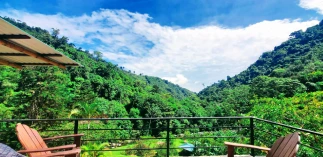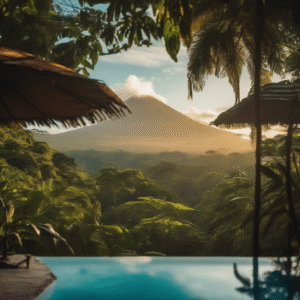Here at our secluded mountain retreat in Costa Rica, mornings erupt in a symphony of buzzing wings and jewel-toned feathers. Among the dazzling cast of avian performers, the Bronze-tailed Plumeleteer takes center stage, a mesmerizing emerald wonder flitting between blossoms.
For those with a keen eye and a patient spirit, spotting this dazzling hummer is a reward all its own. Let’s delve deeper into the captivating world of the Bronze-tailed Plumeleteer, a hummingbird that embodies the vibrant essence of Costa Rica’s rainforests.
A Jewel Amongst Emeralds
The Bronze-tailed Plumeleteer (Chalybura urochrysia) is a medium-sized hummingbird, belonging to the illustrious “emeralds” tribe within the Trochilidae family. True to its emerald namesake, this little marvel shimmers with an iridescent green plumage that appears to shift and change color depending on the light.
But look closer, and you’ll discover subtle details that distinguish this hummer from its emerald kin. A closer look reveals a bronzy sheen on the rump, like a splash of molten copper contrasting the verdant green. This is the telltale sign that helps identify the Bronze-tailed Plumeleteer.
Distinguishing Features: A Birder’s Guide
While the overall green plumage might seem like a common trait among hummingbirds, the Bronze-tailed Plumeleteer has several distinguishing features to aid birders in their quest for identification:
- Red Feet: Unlike many hummingbirds with dark or black feet, the Bronze-tailed Plumeleteer boasts bright red feet, adding a vibrant pop of color. However, females tend to have duller pinkish feet, making them slightly trickier to identify at first glance.
- Bronzy Rump: As mentioned earlier, the most prominent distinguishing feature is the bronzy sheen on the rump. This coppery glint sets it apart from other emerald hummingbirds you might encounter in Costa Rica.
Habitat and Habits: Where to Find the Emerald Jewel
The Bronze-tailed Plumeleteer prefers the emerald embrace of the rainforest, particularly at forest edges and in clearings. Here at our mountain retreat, nestled amidst lush vegetation, you have a high chance of encountering this dazzling hummer.
These solitary birds are typically seen flitting from flower to flower, their wings creating a mesmerizing blur as they hover in mid-air. They favor brightly colored, tubular flowers like heliconias and gingers, perfectly adapted to their nectar-feeding lifestyle.
A Glimpse into the Life of a Plumeleteer
The life of a Bronze-tailed Plumeleteer is a whirlwind of frenetic activity. Their tiny bodies require constant energy replenishment, and they spend most of their day flitting between flowers, their long, slender beaks perfectly adapted for extracting nectar.
The males, with their vibrant plumage, engage in elaborate courtship displays to attract mates. They perform dazzling aerial acrobatics, diving and swirling around potential partners in a captivating display of color and movement.
Witnessing the Magic: Tips for Attracting Plumeleteers
If you’re eager to witness the mesmerizing beauty of the Bronze-tailed Plumeleteer during your stay at our retreat, here are a few tips:
- Visit the Flowers: Hummingbirds are drawn to brightly colored, tubular flowers. Planting these near your balcony or walkways can significantly increase your chances of attracting them. Heliconias, gingers, and red Ixoras are all excellent choices.
- Set Up Feeders: While not a substitute for natural flowers, strategically placed hummingbird feeders filled with sugar water solution can also attract these nectar-loving birds. Opt for red feeders that mimic the color of natural flowers.
- Be Patient and Observant: Hummingbirds are tiny and quick. Remain still and observe the flowers patiently. Once you spot a flash of emerald, keep your eyes peeled for the telltale bronzy rump and red feet to confirm it’s a Bronze-tailed Plumeleteer.
The Bronze-tailed Plumeleteer is a captivating resident of the Costa Rican rainforests. With a bit of patience and the right setting, you might just be lucky enough to witness this emerald jewel flitting amongst the flowers, adding a touch of magic to your Costa Rican retreat experience.
For more information, please view our comprehensive guide about the birds of Costa Rica







